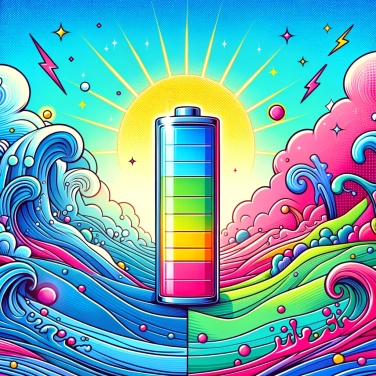High temperatures accelerate chemical reactions inside batteries, causing faster degradation of components and a decrease in their ability to store energy.

Our smartphones use lithium-ion batteries, in which chemical reactions allow for the storage and release of energy. When it’s hot, these chemical reactions become faster and more intense. The heat increases the agitation of the ions, causing the battery to work harder and faster than expected. The problem with this is that it gradually damages the internal components, especially the electrolyte (the conductive liquid inside). As a result, the battery gradually loses its ability to store energy effectively, its lifespan decreases more quickly, and you find yourself charging your phone more often.
When it’s hot, the chemical reactions inside lithium-ion batteries accelerate significantly. This heat particularly boosts the formation of a small layer called SEI (Solid Electrolyte Interphase), which is normally helpful but grows too quickly under heat. Over time, the excess of this layer prevents the battery from transferring lithium ions easily from one side to the other: as a result, your battery's ability to hold a charge decreases, and it degrades faster. Eventually, you notice your phone starting to lose battery life earlier than expected.
A battery regularly exposed to heat will quickly lose its ability to store energy. As a result, your phone starts to discharge much faster (reduced battery life) and needs to be charged more often (shortened charge cycles). High temperatures can also lead to a gradual loss of performance, with slowdowns during resource-intensive activities (like gaming or watching videos), as the battery struggles to meet the phone's demands. Ultimately, after several prolonged exposures, your device no longer lasts as long as expected, and the overall lifespan of your battery is shortened.
Frequent overheating of your phone quickly damages the battery but can also cause other issues. Excessive heat deteriorates the internal components of the smartphone, which may lead to sudden restarts, slowdowns, and even a permanent loss of performance. In the worst-case scenario, a battery that overheats too often swells and can become dangerous: it could leak or even catch fire. A phone that constantly becomes scorching is clearly unsettling, both for you and for your device.
Keep your phone in the shade as much as possible, avoid leaving it in a car or in direct sunlight. Lower its temperature by removing its case, especially if it is thick or insulating. Decrease the screen brightness and disable resource-heavy apps you don't need immediately, as this helps reduce heat production. Charge the phone when it is cooler, such as early in the morning or late in the evening, and avoid using your device while charging in hot weather. If you feel your battery heating up, take a break, turn off the phone for a few minutes to let it cool down.
A rise of just 10°C above the optimal temperature can double the rate at which your smartphone battery ages. Keeping your device out of the sun can therefore significantly extend its lifespan.
Charging your smartphone in a thick protective case on a hot day can significantly increase the internal temperature of the device, leading to accelerated degradation of the battery cells.
Constantly letting your battery reach 0% or 100% further accelerates its aging in hot weather. Instead, try to maintain a charge level between 20% and 80% to prolong its lifespan.
Even in standby mode, your device continues to generate heat in the background, especially during high summer temperatures? Turning it off occasionally or activating airplane mode during heatwaves can make a real difference for your battery.
In some cases, a thick, poorly ventilated, or dark-colored protective case can retain heat, especially during prolonged exposure to sunlight or during intensive charging. It is advisable to use a thin case or to temporarily remove the case when your device overheats.
Fast charging is convenient but generates more heat than standard charging. In high-temperature situations, this additional thermal increase can accelerate the degradation of your battery. Under these conditions, occasionally opt for standard charging to preserve the lifespan of your battery.
Several signs may indicate battery degradation related to excessive heat: significantly reduced battery life, the device feeling hot to the touch even without intensive use, rapid discharge, or sudden shutdown of the phone at unusual percentages. Use the built-in functions of your device or specialized third-party applications to diagnose the health status of your battery.
Yes, there are several free or paid applications (such as AccuBattery, CPU-Z, or Ampere) that allow you to monitor the internal temperature of your battery in real-time and its wear status. This enables you to react quickly when the device overheats.
Charging your phone overnight during periods of high heat can exacerbate overheating and accelerate battery wear. Modern phones often include smart charging management, but it's still best to use an appropriate charger, avoid overly hot environments, and not leave your device plugged in unnecessarily long after it has reached 100%.

No one has answered this quiz yet, be the first!' :-)
Question 1/5